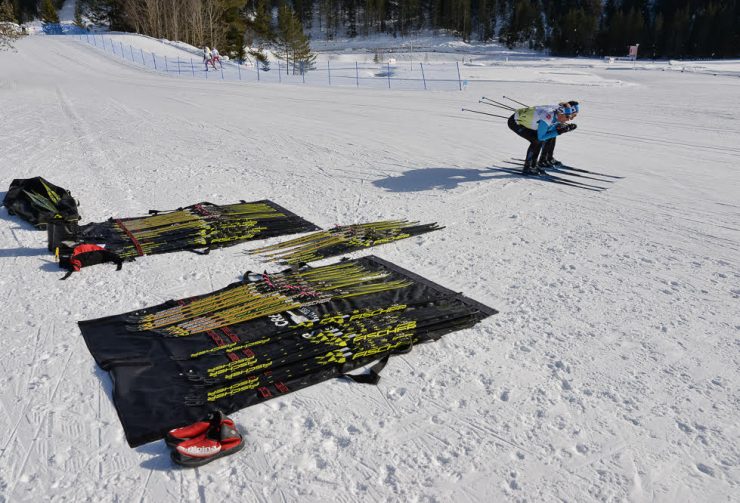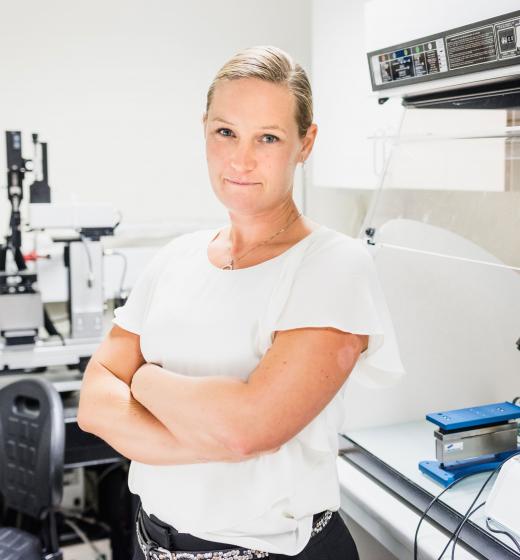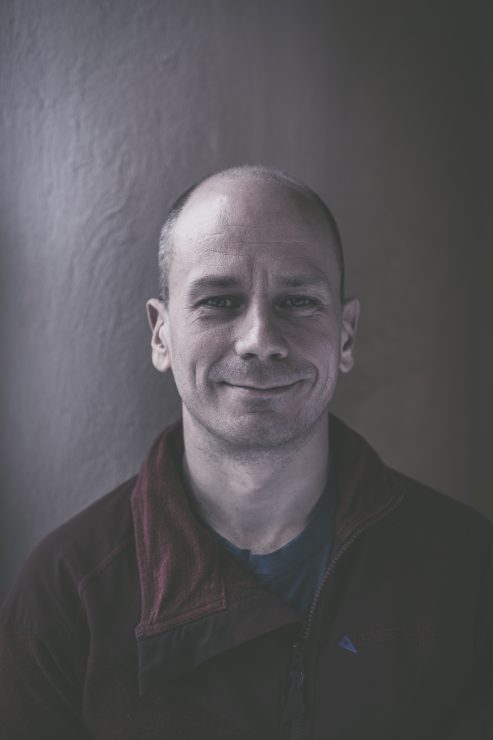
In our commitment to covering the wax ski wax industry, FasterSkier found it relevant to dive deeper into a press release we received on September 4. It came from Sweden based POPFREE Ski Goes Global Project. The project is a collaboration between teams at Peak Innovation and the RISE Research Institutes of Sweden. RISE is a non-profit affiliated with a regional university. RISE bills itself as possessing the research chops and leadership to accelerate innovation.
On its website, Peak Innovation states that it “supports technological innovations and smart sustainable solutions to promote a life in motion for more people.”
Think of Peak Innovation and RISE as innovation hubs involved with this exacting purpose when it comes to ski wax: methodically phasing out the use of perfluorinated ski wax in competitive skiing – both alpine and cross-country.
“One technical challenge resides in the fact, that in certain conditions there are no solutions today offering the same glide,” states the POPFREE press release. “For this reason, solutions are mainly needed in three different areas: innovative fluorine-free waxes, regulations and voluntary bans for wax usage and effective testing to identify unauthorized use in competition. When it comes to rules and testing, they also need to be able to apply from local club level to major international competitions without hampering practice and reducing the attractiveness of skiing.”
What POPFREE advocates is change fostered through discussion, stakeholder buy-in, cultural shifts, new technology, and chemical regulations.
POPFREE has two leads, Joel Svedlund from Peak Innovations and Lisa Skedung from RISE. We spoke to Svedlund and Skedung after they hosted a conference in Sweden to discuss the POPFREE initiative. Many key stakeholders from within the industry and racing scene were in attendance, including Vegard Ulvang, the International Ski Federation’s (FIS) chair of its cross-country committee.
(Here are two links to POPFREE’s survey results. Summary of results from survey: Competitive skiing and fluorinated ski waxes, Results from survey regarding fluorine-free ski waxing.)
Below is the interview with Svedlund and Skedung which has been lightly edited for clarity.
FasterSkier: Can you describe your work in Sweden?

Lisa Skedung: At RISE, we work with different consumer products like textiles and fire fighting foam and food packaging and ski wax is one of the cases. From this project we spun out this POPFREE Ski Goes Global focusing on competitive skiing at international levels because if something should change we believe we have to target competitive skiing because recreational skiers will follow the elite.
Personally, I am a project manager at RISE. I have a background in chemical engineering and I am the project manager for POPFREE Ski Goes Global.
FS: Can you elaborate upon the recent workshop held to discuss fluoro use at high level ski competitions?
LS: Most importantly, we defined the challenges and how to solve the problem.

Joel Svedlund: We wanted to create a road map and initiate a dialogue that can result in further initiatives from this. Our hope is to initiate a couple of projects stemming out of this that will push the issue in various streams.
We had people attend from the wax industry, people from the legislation side involved with REACH legislation, and people from Swedish regulatory agencies, professional ski technicians, national ski associations, to cover the whole chain.
We saw that there was a window of opportunity since things are happening in Norway [to limit fluoro use in junior competitions] and we saw things happening in Sweden. We also have the Vassaloppet, the biggest long distance race in Sweden, they are also on board.
FS: Vegard Ulvang was in attendance. What is your sense that there is buy-in from the upper reaches of the sport?
JS: He was clear on that in our press release. It is our understanding that FIS will probably be open to anything that seems feasible to do. FIS will never push something down which is not accepted on a national level or where there are no methods that work — meaning that the national associations need to take the lead.
There must be things that are tested and applied on the national level so you can see that it is working in actual competitions. When that is operating on the ground it can be moved up to FIS through the national associations. FIS, it is an umbrella organization for all the national associations. In a sense a democracy of those associations. Something that is not supported by national associations won’t happen there.
FS: One of the big concerns in convincing wax users to go fluoro free is the concern that the playing field will be unfair. In other words, if it is a voluntary ban or methods to test for fluoros are costly and/or ineffective, some will choose to go fluoro free, others will choose a competitive advantage and use fluoros.
JS: That is of course one of the big challenges. If you look at other sports or within the sport, of course you have the doping debate and that is very similar to this in many aspects. Especially when you say these substances optimize or enhance your performance and they are very hard to track. In that sense, it is very near the doping discussion. If they would be banned quickly we would have a big challenge how to detect fluoros. Then again, if it comes as a voluntary initiative and you create a cultural norms at the recreational base, then it is accepted and you are accepting this because you want a clean sport.
LS: We talk a lot about how to build trust and create a norm where it becomes about sustainability and how making that choice to not use fluoros can also be somewhat “cool”. Not specifically at the elite level, but as a start with recreationist.
JS: Looking at other sports, you have swimming with limits on suit design and materials, and there’s Formula One with regulations on engines and tire width. People were saying “Formula One will die, we will have slower cars, boring competitions, we won’t have sponsors.” They are thriving still and it is an even playing field.
We will have challenges going through this process but it is also something that will be a process over a number of years.
FS: As we understand it, your work involves creating more awareness among the stakeholders, but also keeping tabs on the evolving nature of the laws regulating the manufacture and use of certain chemicals in Europe. What is going on legislatively when it comes to fluoro use in Europe.
JS: The people working on legislation say that somewhere between five and fifteen years – give or take – that we will have enough regulation on the substances that can be used in, for example, ski waxes, that it will not be possible to use fluoros in them from a legislative standpoint in Europe.
How it is going to be in the U.S. or in Asia we do not know. But we do know that in Europe if you look at the trend, how legislation is working right now, there will probably be categorizing necessary and unnecessary uses for fluoros. And ski waxes have a very hard time falling into the necessary uses.
That means once it is categorized as a non-necessary use, it must meet high requirements to be used in any substance.
Another thing regulators are exploring is going from regulating one substance at a time to taking groups of substances, especially for the non-necessary uses. For fluorinated substances, the PFAS is a group of at least 4700 substances. Now in the EU there are two groups actually regulated, PFOS is legislated against totally and PFOA [C8] is coming next year in the EU as a ban more or less.
What we see now too, is that in order for manufacturers to continue selling, for example, fluoro powders, they are going to what is called the C6 technology, or shorter chain fluoros. And if you ask the legislatures they say what is going to happen in a couple of years is that most of the C6, maybe all of them will be legislated against. Because we are already putting them on the hazard list. They show similar health risk. We know it is going towards that. And as it continues along that line with different substances, it is always a hunt for the next best thing.
In the next couple of years, when this unnecessary use is possibly designated and the group regulations come, then the whole group of substances will be impossible to use. Then asking if it is possible to test for fluoros at races, and can we have voluntary bans — when we come to that point with regulations, it won’t matter.
LS: But legislation is very slow. There is a long way to go before legislation.
JS: That is true. So it is also important that we have spoken to national ski associations. They see the good will of their brand and the sport and that they don’t want to be seen as laggards. They are all using nature to have good health and good recreation. Nobody wants to be seen as the polluters.
Society is starting to see PFAS as a huge problem which is still a bit unknown. But once that happens on a larger scale, the ski sport does not want to stand there and say “we need to use this otherwise we won’t be able to win our races.” There is that element too.
FS: What can you tell us about some of the fluoro testing on skis that occurred at a few junior races in Norway last year? [The use of perfluoroinated wax is banned there in competitions involving skiers 16 years old and younger.]
JS: For now it is the sampling methods, you are taking chemical samples from the skis and then sending it to the lab. The sampling itself is very low cost. It takes about one minute or two and is actually a small sampler with an adhesive that you push on the skis.
LS: And you analyze the removable fluorine on that.
FS: What are the cost breakdowns for sampling and testing for fluoros on a ski?
JS: I don’t know the exact price for the sampler, it is not more than 10 or maybe 20 euro maximum. They have said it has an adhesive pad that is removable and exchangeable.
The actual sampling is relatively low cost. The analysis takes about two to three days with transport back and forth — the lab is in Germany. They say one week for receiving the results. I believe the total cost for sampling and analysis is about 100 euro per sample.
But it is developable, we have discussed this a lot. This is one aspect we will try to push forward, to develop the test methodology. Because they know that, of course, sending the sample to a lab in Germany works, even in doping it works too — but if it is possible to have onsite analysis and to give answers within a couple of hours it is much better.
Even within a couple of minutes or seconds is the holy grail.
LS: In the workshop we also talked about the way it will continue this winter. It will be tested in more competitions and maybe in some big ones. The key is that you can sample, it is quick. You can take many samples and you can decide after the race which samples you want to analyze. You may not have to analyze all of the samples. Maybe just the top-10, or maybe just some randoms ones with the top-10.
FS: It is human nature, that even with the prospect of testing, even if the testing never occurs, some part of the racing population will be deterred and follow the rules.
JS: You can see that in the first two testing pilots from Norway. They did two youth competitions which was highly debated in Norway. At the first race where they tested for fluoros, they had 50% with probable fluorine content on the skis.
The actual ban had been going on for one year with no testing. Also, they did announce testing would be conducted, but they had not gone through in detail how you make a ski thoroughly fluorine free. Do you switch brushes? Do you clean the skis three or four times with wax remover?
This communication was missing and also probably there were some people thinking “hey, I don’t think they will see anything anyway”. However, 50% of the skis were found to be probably contaminated.
At the next competition where they tested, they had only 20% contamination. Immediately when you started looking into this people said “oh, it can happen.” Of course you also had a methodology established to clean skis and be fluoro free and then the percentage of contaminated skis lowers.
LS: The good thing, it was reported also that the atmosphere at the competition, once it was clear it was fluorine free and we are not using any powders and all of that, they said the atmosphere in the waxing tents among the parents and the cubs was perceived to be better.
Jason Albert
Jason lives in Bend, Ore., and can often be seen chasing his two boys around town. He’s a self-proclaimed audio geek. That all started back in the early 1990s when he convinced a naive public radio editor he should report a story from Alaska’s, Ruth Gorge. Now, Jason’s common companion is his field-recording gear.



